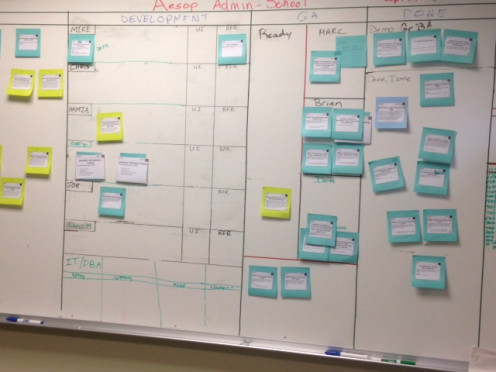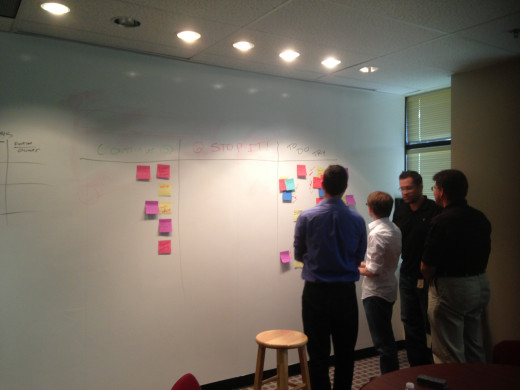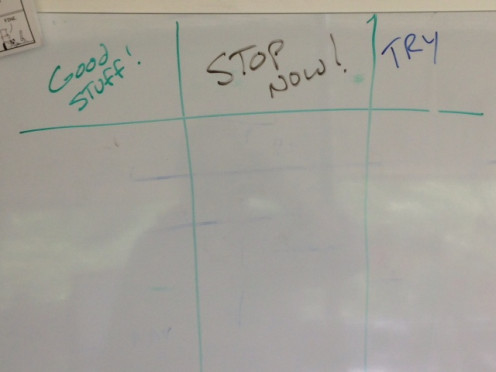Improving Agile Scrum - Making Team Retrospectives Count
High Performing Agile Team

Retrospective Report Card?
My teams last retrospective was....
Is your development team performing?
Scrum is a popular development management methodology that promotes expedient delivery of business value buy promoting self managing teams and continual improvement. In practice Scrum requires a unique balance between the adherence to Agile's guiding principals and flexibility and learning in process to truly perform. In the short term teams almost always immediately benefit from the structure and ceremonies introduced when learning Agile Scrum applies. Teams will make drastic improvements just by simply applying and following the basic rules. However over time many struggle with ways to continually improve and constantly excel as very high performing teams.
Scrum - One reason teams stop improving
If you have run Agile Scrum long enough you will start to realize that team unity, drive, focus and performance can all be boiled down to one key area. This area being how well a team communicates with each other. Not just the good but the problem areas and the ability to have meaningful and professional discussions on how to resolve or not resolve areas of friction. When this happens it might be time to evolve and try some new things.
In the beginning many agile scrum teams are taught the 3 question method for retrospecting.
- What did we do well?
- What did we not do well?
- What do we want to try?
This is usually taught to scrum masters as something that is run as an open forum discussion. The question is asked and every team member has an opportunity to talk and contribute their opinions. Initially this is a good approach and major issues will quickly rise to the surface and be addressed. Everyone feels good, we hug, we high 5 and we move on to plan the next sprint. I find these early issues are usually glaring well known problems that are either process driven or center around grooming and preparedness items. Over time what I see happen is that a few voices become dominant on the team and start driving the conversations, while others start to lose their voice in conversation. Sure we want to coach and encourage everyone to participate and often they do after some coaxing, that is at least for a little while. But eventually these cycles will repeat and the team will start to stagnate on improvement. Is this happening on your teams? Let look at some symptoms that you should look for.
Team Health Symptoms Checker
- Do a few individuals dominate the conversation in retrospectives?
- Do the same issues continually come and go without true resolution or progress?
- Is the list of items become too large or overwhelming to work on?
- Is the team starting to express frustration with Scrum or Agile?
It might be time for a change
If you are starting to experience the symptoms in the above section, then it may be time for a change. Something to refresh the spirit of conversation and allow the team to focus on the issues that need to be focused on. As scrum master it is you responsibility to keep team morale and synergy moving forward. If we are not doing this then we are failing out teams.
Agile teaches us to fail quickly and innovate. Yet when it comes to cermony, communication and process we often allow these to fail and be ineffective for long periods of time. Why? We need to approach our own processes with the same spirit of try to fail if needed that agile encourages us to do. In short if it ain't working.. change it!
There is an alternate approach to retrospectives that I would like to introduce to you. It may work and be what your teams need to re-invigorate the spirit of being a team. Hopefully you will find success and improvement with it, but if you don't I encourage you to seek out and experiment with others until you find one that fits the personality of your team.
Supplies Needed
It would not be Agile if it did not require props!
- Post-It Notes 1 pad for each team member
- Sharpies - 1 for each team member
- Timer
- Wall (White board works best, you'll see why below)
Discussions at the Board

Get it on the table


Running the Retrospective
- Open the meeting
- On a white board create three columns
- Continue to do well!
- Stop Doing Now
- New Things to Try?
- Distribute the post it notes to each team member.
- Give the team 5 minutes to write out items on post it notes, explain that each note must go under one column on the board. They do not need one for each column, they just need to know what one it belongs under. No more writing after this.
- At the end of the 5 minutes, You will give each team member 2 minutes to explain their post it and place it in the correct column. This is two minutes per/person for all their notes.
- At the conclusion you will want to recruit some volunteers to help group items of common themes together in their columns. For example "Development Delivered too late to QA" and "QA did not complete all stories in time" are two different sides to the same issue. They should be arranged together on the board in a common grouping.
- Next we will move to voting. Voting is used intentionally to give the team a semi-anonymous voice to raising concerns. Using a marker each team member is given three votes (Check Marks). The team is ONLY allowed to vote for items in the STOP or TRY columns. In this retrospective the GOOD column is for Praise, Kudo's or reinforcement of good work done. Note: Voting should be done in mass where the entire group is released to the board to vote. This helps limit some of the herding mentality or pressure to follow one persons lead.
- Once everyone has voted it is time to prioritize the team concerns into topics. From the voting you hopefully will have one or two clear winners. So now that you now have a focal topic, you need to get the team engaged in real conversation about it. I like to open these with something like "Well, who voted for this one?" I then pick person and ask them to explain why. It is important to allow multiple voters to comment on the topic. You want to be aware an intentionally ask people to hold off on defensive comments until others have vocalized their concerns. As scrum master you will want to work on helping them dig, really dig in the truth or root of the problem. If you don't allow the team to reach the honest reality of the issue they will never resolve it. While i like to try and time box this to 20 minutes, sometimes it is more important to let the team continue until resolution.
- Fear of conflict is sometimes an issue. As you know problems sometimes are not always team based. Unfortunately there are times when they have a single name attached to them. Many times these issues are shied away from to avoid conflict. For a team to truly perform they must get over this. They will need to know how to address specific problems and communicate them in ways that are professional. The reality is while they may not want to hurt someones feeling, that person already know there is a problem. Defensive or angry reactions have more to do with the delivery then the message. When these come up, guard aggressively against personal attacks, disarm them. Instead push for getting the problems created for others by the problem. Above all insist it never becomes personal.
Closing Comments
Scrum Master is the an important role on the team. At time is can be thankless and monotonous as every sprint you make sure roadblocks are cleared, sprints are planned and grooming session happen. The retrospective is one of the few opportunities you have to influence coach and guide your team into something better. Being able to put the coaches hat on and help your team become something awesome can be very rewarding. Keep in mind that your team will follow your lead, your tone, your example. If you approach it with no preparation and energy the team will follow suit. Be prepared and approach each retrospective with the goal having the team be better. Be a leader when you need the team to work through the difficult issues and they will follow.
Agile Adoption Time
How long has your team been practicing Agile Scrum
Help Spread the Word
If you have found the information in the article helpful please take a moment to share it with others.
You can do this by:
- Liking on Facebook
- Pinning on Pintrest
- Tweeting it on Twitter
It will only take a few seconds and the tools to do this are right on this page. By doing so you help increase this pages overall search engine rankings and increase the chances of someone else discovering this page.
Thank You kindly









